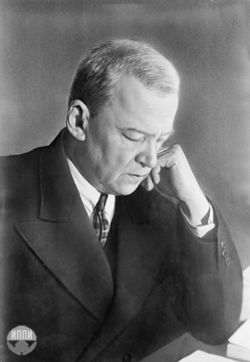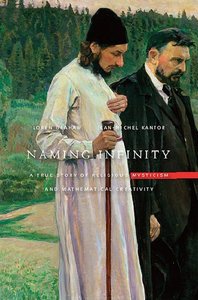
BIOGRAPHY OF N. N. LUZIN
(1883-1950)
-
born December 09, 1883, Irkutsk, Russia.
died January 28, 1950, Moscow, Russia.
|
|
BIOGRAPHY OF N. N. LUZIN
|
Biographic Data of N. N. Luzin:
Nikolai Nikolaevich Luzin (also spelled Lusin; Russian: Николай Николаевич Лузин)
was a Soviet/Russian mathematician known for his work in descriptive set theory and aspects of mathematical analysis with strong connections
to point-set topology. He was the co-founder of "Luzitania" (together with professor Dimitrii Egorov), a close group of young Moscow mathematicians of the first half
of the 1920s. This group consisted of the higly talented and enthusiastic members which form later the core
of the famous Moscow school of mathematics.
They adopted his set-theoretic orientation, and went on to apply it in other areas of mathematics.
Luzin started studying mathematics in 1901 at Moscow University, where his advisor was professor Dimitrii Egorov (1869-1931).
Professor Dimitrii Fedorovihch Egorov was a great scientist and talented teacher; in addition he was a person of very
high moral principles.
He was a Russian and Soviet mathematician known for significant contributions to the areas of differential geometry and mathematical analysis.
Egorov was devoted and openly practicized member of Russian Orthodox Church and active parish worker.
This activity was the reason of his conflicts with Soviet authorities after 1917 and finally led him to arrest and exile to
Kazan (1930) where he died from heavy cancer.
From 1910 to 1914 Luzin studied at Gottingen, where he was influenced by Edmund Landau.
He then returned to Moscow and received his Ph.D. degree in 1915. During the Russian Civil War (1918–1920) Luzin left
Moscow for the Polytechnical Institute Ivanovo-Voznesensk (now called Ivanovo State University of Chemistry and Technology).
He returned to Moscow in 1920. On 5 January 1927 Luzin was elected as a corresponding
member of the USSR Academy of Sciences and became a full member of the USSR Academy of Sciences first at the
Department of Philosophy and then at the Department of Pure Mathematics (12 January 1929).
In the 1920s Luzin organized a famous research seminar at Moscow University. His doctoral students included some of the most famous Soviet mathematicians: Pavel Aleksandrov, Nina Bari, Aleksandr Khinchin, Andrey Kolmogorov, Alexander Kronrod, Mikhail Lavrentyev, Alexey Lyapunov, Lazar Lyusternik, Pyotr Novikov, Lev Schnirelmann and Pavel Urysohn.
Luzin's first significant result was a construction of an almost everywhere divergent trigonometric series with
monotonically converging to zero coefficients (1912). This example disproved the Pierre Fatou conjecture and was unexpected
to most mathematicians at that time. At approximately the same time, he proved what is now called Lusin's theorem in real analysis.
His Ph.D. thesis entitled Integral and trigonometric series (1915) made a large impact on the subsequent development of the
metric theory of functions. A set of problems formulated in this thesis for a long time attracted attention from
mathematicians. For example, the first problem in the list, on the convergence of the Fourier series for a square-integrable
function, was solved by Lennart Carleson in 1966.
In the theory of boundary properties of analytic functions he proved an important result on the invariance of sets of
boundary points under conformal mappings (1919).
Luzin was one of the founders of the descriptive set theory. Together with his student Mikhail Yakovlevich Suslin,
he developed the theory of analytic sets.
He also made contributions to complex analysis, the theory of differential equations, and numerical methods.
Imiaslavie (Russian: Имяславие) or Imiabozhie (Имябожие), also spelled imyaslavie and imyabozhie, and also referred to as onomatodoxy, is a dogmatic movement which was condemned by the Russian Orthodox Church, but that was promoted by some group of the Russian Orthodox believers, and by some other contemporary Russian writers (many of whom are associated with St. Sergius Orthodox Theological Institute in Paris), which asserts that the Name of God is God Himself. The movement emerged in the beginning of the 20th century but both proponents and opponents claim it to be connected with much religious thought throughout the history of Christianity (proponents claim its connections to the Church Fathers, while opponents claim the connections to the ancient heresiarchs).
Luzin was in close contacts with famous orthodox priest and Church author rev. Pavel Florensky (January 21, 1882 - December 1937).
The Luzin affair of 1936.
On 21 November 1930 the declaration of the “initiative group” of the Moscow Mathematical Society which consisted of former
Luzin's students Lazar Lyusternik and Lev Shnirelman along with Alexander Gelfond and Lev Pontryagin claimed
that “there appeared active counter-revolutionaries among mathematicians.” Some of these mathematicians were pointed out,
including the advisor of Luzin, Dmitri Egorov. In September 1930, Dmitri Egorov was arrested on the basis of his religious
beliefs. After arrest, he left the position of the director of the Moscow Mathematical Society. The new director became
Ernst Kolman. As a result, Luzin left the Moscow Mathematical Society and Moscow State University. Egorov
died on 10 September 1931, after a hunger strike initiated in prison. In 1931, Ernst Kolman made the first complaint
against Luzin.
In July–August 1936, Luzin was criticised in Pravda in a series of anonymous articles whose authorship later was attributed
to Ernst Kolman. It was alleged that Luzin published “would-be scientific papers,” “felt no shame in
declaring the discoveries of his students to be his own achievements,” stood close to the ideology of the “black hundreds,”
orthodoxy, and monarchy “fascist-type modernized but slightly.” Luzin was tried at a special hearing of the
Commission of the Academy of Sciences of the USSR, which endorsed all accusations of Luzin as an enemy under the mask of a
Soviet citizen. One of the complaints was that he published his major results in foreign journals. This method of political
insinuations and slander was used against the old Muscovite professorship many years before the article in Pravda.
The political offensive against Luzin was launched not only by Joseph Stalin's repressive ideological authorities, but also
by a group of Luzin's students headed by Pavel Alexandrov, who may have been pressured to it by threats to reveal his
homosexual relationship with Andrey Kolmogorov. Although the Commission convicted Luzin, he was neither expelled from the
Academy nor arrested. There has been some speculation about why his punishment was so much milder than that of most other
people condemned at that time, but the reason for this does not seem to be known for certain.
Historian of mathematics A.P. Yushkevich speculated that at the time, Stalin was more concerned with forthcoming Moscow
Trials of Lev Kamenev, Grigory Zinoviev and others, and that the eventual fate of Luzin was of little interest to him.
The 1936 decision of the Academy of Sciences was not cancelled after Stalin's death. The decision was reversed on
January 17, 2012.

The BIOGRAPHY of N. N. LUZIN can be found in a few places.
Wikipedia electronic Encyclopedia(http://en.wikipedia.org/) , an article N. N. LUZIN.
Additional data and very useful historical account can be found in the books and other publications:
1. Колягин Ю.М., Савина О.А., Дмитрий Федорович Егоров: Путь ученого и христианина.
отв. ред. проф. В.И. БОГАЧЕВ.
Изд. Свято-Тихоновского Университета, Москва, 2010. 302 с. [in Russian]
For a more detailed discussion of Kolmpgorov's works see the Review Paper:
A. L. Kuzemsky, Probability, Information and Statistical Physics.
International Journal of Theoretical Physics,
Digital Object Identifier (DOI) 10.1007/s10773-015-2779-8